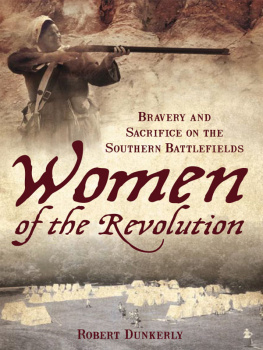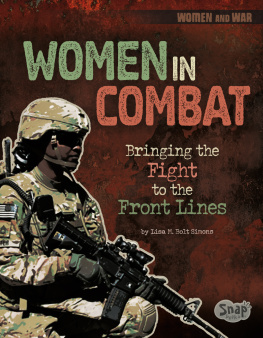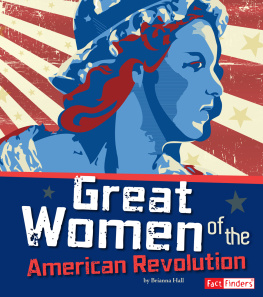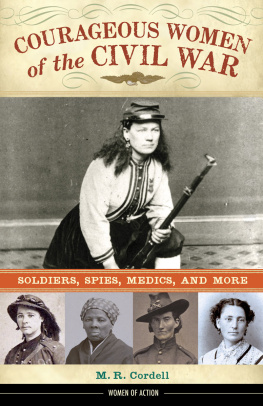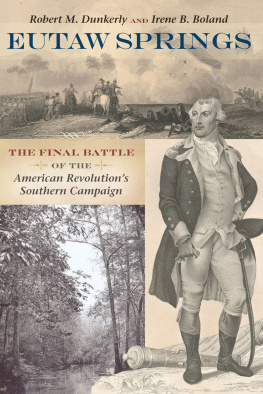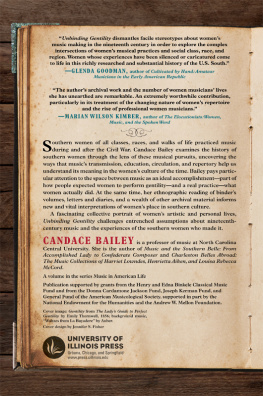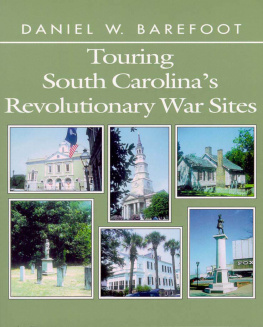

Published by The History Press
Charleston, SC 29403
www.historypress.net
Copyright 2007 by Robert M. Dunkerly
All rights reserved
Cover image: Photo illustration by Marshall Hudson featuring reenactment of the British Camp at Eutaw Springs, South Carolina.
First published 2007
Second printing 2010
Third printing 2011
Fourth printing 2013
e-book edition 2013
ISBN 978.1.62584.489.7
Library of Congress Cataloging-in-Publication Data
Dunkerly, Robert M.
Women of the Revolution : bravery and sacrifice on the Southern fields / Robert M. Dunkerly.
p. cm.
Includes bibliographical references.
print edition ISBN-13: 978-1-59629-389-2 (alk. paper)
1. Southern States--History--Revolution, 1775-1783--Women. 2. United States--History--Revolution, 1775-1783--Women. 3. Women--Southern States--History--18th century. 4. Women--Southern States--Biography. 5. Southern States--History--Revolution, 1775-1783--Social aspects. 6. United States--History--Revolution, 1775-1783--Social aspects. 7. Southern States--History--Revolution, 1775-1783--Campaigns. 8. United States--History--Revolution, 1775-1783--Campaigns. I. Title.
E276.D86 2007
973.3082--dc22
2007040045
Notice: The information in this book is true and complete to the best of our knowledge. It is offered without guarantee on the part of the author or The History Press. The author and The History Press disclaim all liability in connection with the use of this book.
All rights reserved. No part of this book may be reproduced or transmitted in any form whatsoever without prior written permission from the publisher except in the case of brief quotations embodied in critical articles and reviews.
Contents
Acknowledgements
Several people helped with this project. I would like to thank Mickey Crowell of the Kings Mountain Historical Museum; Virginia Fowler of Cowpens National Battlefield; Nancy Stewart of Guilford Courthouse National Military Park; Hattie L. Squires of Moores Creek National Military Park; Brian Robeson and Frank Stovall of Musgrove Mill State Historic Site; historians John Rees and Don Hagist; Loyalist expert Todd Braisted; researchers Deb Peterson, Elizabeth Melton, Arlene Mackey and Elaine Sprinkle; and Jon Zachman of the Greensboro Historical Museum. John Robertson provided the excellent maps. Researcher Karen A. Smith assisted by graciously sharing her cutting edge work on womens clothing from primary sources. Her final product will be a valuable contribution to colonial scholarship.
Introduction
The women of the Revolution and their deeds are too numerous to recount in any single book. Women were active on both sides, in every area and in nearly every military action. No single book could cover all of the activities of those who were actively involved.
This work takes a different approach to the topic of women in the Revolution. There are nearly a dozen existing titles about this topic, ranging from general overviews of women to others highlighting famous women to those that emphasize their contributions as founding mothers. There are also more detailed studies about women in the conflict: analyzing the camp followers, the spies, the soldiers like Deborah Sampson; works that examine womens roles, their changing political rights and the conflicts effect on them.
This study does not intend to study the role of women or their larger contributions, nor does it romanticize them or retell inspiring stories of women who faced invaders on their doorsteps. Like the men they served with, some women rose to the occasion and helped their cause and others acted with less than grace, but all were deeply affected by events and caught up in the struggle. Unfortunately, many of the stories were only passed down orally until recorded one hundred years later by historians. These accounts were often one-sided, exaggerated and embellished.
What this work hopes to cover is the presence of women on specific battlefields, no matter what their part. Some were active participants, others mere observers. From researching the records, one thing is clear: women were there, at nearly every fight, yet they are invisible to us today. Military records speak only of the men. Historians in the nineteenth and twentieth centuries relied on those records to write their studies and interpretations of the battles. Women may have been mentioned, but they often were not. The records were produced by, and written about, men. Most of the women who were present at these events were probably illiterate, and few left accounts of their experiences.
Until the 1960s, most histories of the Revolution focused on military and political events. New ground was broken in that decade as historians began to examine the roles of women and other minorities, but their studies were often focused on upper-class women, or they studied womens roles in the political realms. Women who followed the armies or were present on battlefields received little attention. Several good studies were done in the 1980s and 1990s on camp followers, but few have examined women at specific battle sites of the Carolinas.
Women were involved in nearly every battle of the war. They were camp followers, performing vital functions that kept the armies running. They were civilians, caught up in the movements of armies. They were spies and scouts, using their freedom of movement to their advantage. They often came to the battlefields to help nurse the wounded. Sometimes they fought as well, either openly as women or disguised as men.
Unlike warfare among the large armies of North and South in the Civil War, during the Revolution women were commonly attached to or involved with the eighteenth-century armies and their campaigns. The nature of the war in the Southern colonies often put civilians into the fray; this was a war among militias, among neighbors.
There is an important distinction to draw, and it will be more fully explored below. Some women were attached to the armies; others were accompanying the militia or caught up in the guerilla warfare that raged among civilians. The experiences of these two types of women differed greatly.
Thus in the case of militia (Loyalist or Whig), women were often in or near battles, and encountered armies and the small foraging or raiding parties that roamed the countryside. Women frequently visited husbands, brothers and sons in militia camps. They often were with the armies as refugees. They were in the front lines, since in this guerilla war the front line was everywhere.
Those who were attached to regular British and American armies shared experiences that were similar to those who fought in the large Northern battles. These ladies were part of the army and subject to its military discipline. They marched, received rations, suffered from the elements, were subject to military discipline and sometimes found themselves in combat.
All of the women who were involved in these battles played important, if little-known, roles. Their stories have largely not been recognized. This work attempts to bring them to the forefront.
Part I
Setting Time and Place
The Values of the Eighteenth-century World
The scene was repeated time and time again on battlefields: as the smoke clears and the firing ceases, soldiers move out across a battlefield littered with dead and wounded. Dismounted cannons, abandoned wagons, dead horses and the debris of battle: broken muskets, abandoned packs and overturned fences litter the area. Amid the exhausted soldiers, here and there, are women. They are part of the army, and they have experienced the battle as well.
Next page
